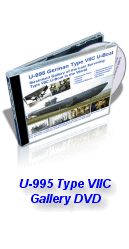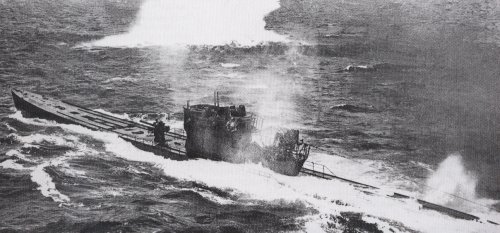

|
Type IX U-Boat
 |
The Type IX was designed with two objectives in mind – to be the long range counterpart to the medium-range Type VII, and to serve as a tactical command boat for the leader of a wolf pack. After the fall of France, the second requirement became unnecessary as the powerful land based transmitters on the French coast meant that tactical command could be handled from shore.
|
|
|
|
Authored by Uboataces |

|
The Type IXs were excellent sea boats, which had sufficient range to operate in distant waters in the South Atlantic, Indian and even the Pacific oceans - although some had even reached the east coast of North America. It was designed to travel fast to and from distant operational zones, while carrying an adequate supply of torpedoes and stores for sustained solo patrols. It carried more torpedoes than the Type VII but was handicapped with a slow diving time and was more vulnerable to attack – mainly due to its comparatively large size.

|
| A Type IXD2 under attack from US aircraft. The two flakvierling appears to be pointed in different directions, indicating it is under attack by more than one aircraft. |
This model was much bigger, longer and employed more powerful diesel engines. It used a supercharged 9-cylinder diesel instead of the standard 8-cylinder on the Type VIIs. To balance the much heavier weight, the engine room was located immediately rear of the control room. The Type IX had a full double hull, with the outer hull almost completely surrounding the pressure hull. The upper deck was wide and flat, which provided additional space to store ten torpedoes externally in watertight containers. When the war started, the standard gunnery of the Type IX was one 105mm deck gun, one 37mm flak and one C30 machine gun. It had four forward torpedo tubes and two backward tubes, with a total capacity of 22 torpedoes.
Together with the Type VII, the Type IX combined to form the backbone of the U-boat force, which had fought relentlessly for control of the shipping lanes of the Atlantic. More than 200 Type IXs were built in seven sub-classes.
Type IXA

The first of the original design, a total of eight Type IXAs were built. The first was U-37, launched on May 4 1938, and commissioned on August 4 1938. It was equipped with three periscopes, two in the conning tower and one in the control room.
Type IXB

Fourteen Type IXBs were built. The fuel capacity was increased from 154 tons to 165 tons, giving a slightly extended range from 8,100nm to 8,700nm.
Type IXC

Fifty four Type IXCs were built. The main difference was an increased fuel capacity to 208 tons, resulting in an extended range from 8,700nm to 11,000nm. This subclass onward had two periscopes, both housed within the conning tower.
Type IXC/40
Eighty seven Type IXC/40s were built. The fuel capacity was yet further increased to 214 tons, giving an extended range to 11,400nm.
Type IXD
A highly desirable trait was for a U-boat which could combine high speed with very long range. However given the technology of the day, it was recognized that to develop such a boat would cause excessive complications. Instead, it was decided to develop two versions, one which maximized speed, and the other very long range. This led to the design of the Type IXD1 (speed) and IXD2 (range).

Only two Type IXD1s were built, U-180 and U-195. Their standard diesel engines were substituted with six Daimler Benz MB501 diesels, producing an output of 1,500hp each. Though the maximum range was somewhat reduced, this design could achieve a respectable top speed in excess of 20 knots. Considerable technical problems were encountered, including overheating and the emission of white exhaust smoke which was visible for miles. The unsatisfactory engines were removed and the original MAN engines were reinstalled. They were later converted to transport U-boats and could to carry up to 252 tons of cargo. In this configuration, the torpedo tubes were removed to provide additional cargo room. Both variants of the Type IXD1s were equipped with a Focke Achgelis, a rotary winged kite for making distant observations.

Twenty eight Type IXD2s were built. In addition to their standard MAN diesel engines, this variant had two additional six cylinder diesels which could be used for cruising on the surface. They had additional fuel bunkers, giving them the exceptional range of 23,700nm – the longest range of any German attack U-boat. Like the IXD1, it was equipped with a Focke Achgelis kite.
Technical Specification
| Type IXA | Type IXB | Type IXC | |
| Role | Long Range Attack U-boat |
Long Range Attack U-boat |
Long Range Attack U-boat |
| Displacement Surfaced Submerged |
1,032 tons 1,153 tons |
1,051 tons 1,178 tons |
1,120 tons 1,232 tons |
| Dimensions Length Beam Draught |
251.0ft (76.5m) 21.3ft (6.5m) 15.4ft (4.7m) |
251.0ft (76.5m) 22.3ft (6.8m) 15.4ft (4.7m) |
252.0ft (76.8m) 22.3ft (6.8m) 15.4ft (4.7m) |
| Top speed Surfaced Submerged |
18.2 knots 7.7 knots |
18.2 knots 7.3 knots |
18.3 knots 7.3 knots |
| Maximum range Surfaced at 12kt Submerged at 4kt |
8,100nm 65nm |
8,700nm 64nm |
11,000nm 63nm |
| Crush depth | 656ft (200m) | 656ft (200m) | 656ft (200m) |
| Weapons Bow tubes Stern tubes Torpedo capacity Mines Guns |
Four 21 inch Two 21in 22 None 1 x 105mm cannon 1 x 37mm Flak 1 x 20mm Flak |
Four 21 inch Two 21in 22 None 1 x 105mm cannon 1 x 37mm Flak 1 x 20mm Flak |
Four 21 inch Two 21in 22 None 1 x 105mm cannon 1 x 37mm Flak 1 x 20mm Flak |
| Crew | 48 | 48 | 48 |
| Total built | 8 | 14 | 54 |
| Type IXC/40 | Type IXD1 | Type IXD2 | |
| Role | Long Range Attack U-boat |
Long Range Attack U-boat |
Long Range Attack U-boat |
| Displacement Surfaced Submerged |
1,144 tons 1,257 tons |
1,610 tons 1,799 tons |
1,616 tons 1,804 tons |
| Dimensions Length Beam Draught |
252.0ft (76.8m) 22.6ft (6.9m) 15.4ft (4.7m) |
287.4ft (87.6m) 24.6ft (7.5m) 17.7ft (5.4m) |
287.4ft (87.6m) 24.6ft (7.5m) 17.7ft (5.4m) |
| Top speed Surfaced Submerged |
18.3 knots 7.3 knots |
20.8 knots 6.9 knots |
19.2 knots 6.9 knots |
| Maximum range Surfaced at 12kt Submerged at 4kt |
11,400nm 63nm |
9,900nm 57nm |
23,700nm 57nm |
| Crush depth | 656ft (200m) | 656ft (200m) | 656ft (200m) |
| Weapons Bow tubes Stern tubes Torpedo capacity Mines Guns |
Four 21 inch Two 21in 22 None 1 x 105mm cannon 1 x 37mm Flak 1 x 20mm Flak |
Four 21 inch Two 21in 24 None 1 x 105mm cannon 1 x 37mm Flak 1 x 20mm Flak |
Four 21 inch Two 21in 24 None 1 x 105mm cannon 1 x 37mm Flak 1 x 20mm Flak |
| Observation kite | None | Focke-Achgelis FA-330 | Focke-Achgelis FA-330 |
| Crew | 48 | 55 | 57 |
| Total built | 87 | 2 | 28 |



